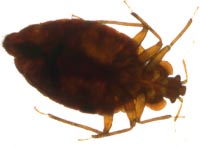BED BUGS

The Problem
Until recently bed bugs have not been a problem. However, they are rapidly spreading and can be found almost anywhere, including homes, stores, the workplace, and hotels and residence halls/dormitories of all types. Bed bugs can arrive at your home as hitchhikers on luggage or clothing, multiplying rapidly. They tend to live near their food source, human blood, and therefore seek hiding places close to you, on your bed, couch, or other furniture. Bed bugs have several growth stages, from quite small to about 1/4 inch long. An adult specimen is shown here, magnified. After feeding they turn a reddish brown color, and excrete small dark spots as they digest a meal of blood.
Chemical treatments, sometimes costing thousands of dollars, have been the traditional way to treat these pests, and, due to their ability to hide in places the chemicals don’t reach and resistance to many pesticides, they have a maddening tendency to return. Since these chemical treatments cannot reach all of the hiding places, it is recommended that infested items such as bedding, TVs, couches, and other furniture be discarded, adding greatly to the expense of chemical treatment. However, now there is a product line of heat treatment equipment, with the ability to kill all these pests anywhere in a room, in a single 4 or 5 hour treatment.
A Growing Problem
The Bed Bug has been identified as a pest for as long as there is a recorded history, and has evolved to effectively coexist with us. We have probably all heard the old rhyme that ends with “… and don’t let the bed bugs bite”. With the introduction of DDT in the 40′s the problem in the US subsided significantly. Development of chemical resistance by the pest to many currently available pesticides and the elimination of DDT, coupled with a dramatic increase in our appetite for travel, are key elements responsible for the recent bed bug explosion in our homes, residence halls, dormitories, hotels, airplanes, stores, and yes, even the workplace.
Bed bugs which are generally nocturnal and cause a stinging sensation as they feed, generally reside in cracks and other hiding place near the host and next meal. Since they cannot fly and are not fast enough to simply disappear, quickly look near the area of the bite where the bug will often be present. If you suspect that you have bed bugs look for evidence of the insects near the head of the bed, between the mattress and spring, or in the areas behind the headboard. As soon as a biting sensation is felt look to see what caused it. Bed bugs are easy to spot in this way, and proof positive is useful to insure that you seek proper treatment.
Life Cycle
A bed bug can reproduce at an alarming rate, with the female laying up to 500 eggs in her short lifetime. Obviously, one pregnant bug can create a disgusting itchy problem in a relatively short time. Not just confined to your mattress, the bugs can live in chairs, furniture, behind wall hung pictures, under your carpets, and even behind decorative trim molding. They may arrive on luggage or clothing, perhaps from a recent trip to a nice hotel or resort, or even from a visit to an infested room in the same building.
The bite symptoms include itchy red welts or puffed up skin in the bite area. These appear within a day or several days after the bite. However, not all people have a significant reaction. The bites most frequently appear on exposed skin, such as on the arms, legs, or head Bites often appear in a pattern or cluster. The bugs feed, much as a mosquito does, through a tube that is inserted into the skin. They inject an anti-coagulant in their saliva to more effectively suck blood. The swelling is typically an allergic response to the bed bug saliva.




